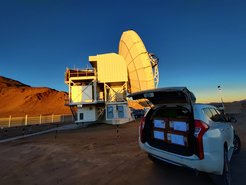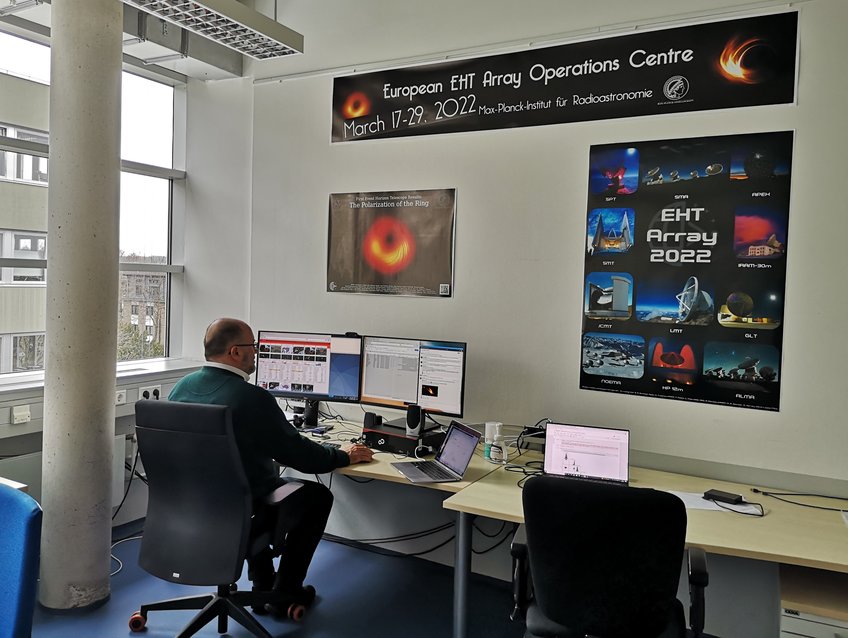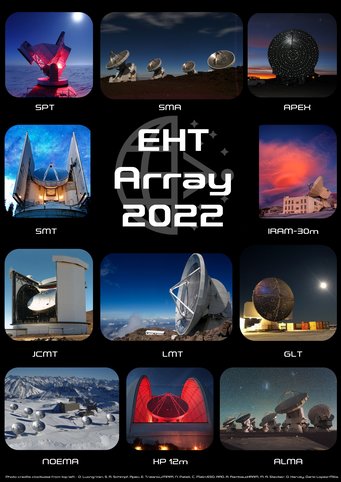Event Horizon Telescope 2021
Observing campaign in April 2021: world-wide radio telescope network retakes observations after 3-year long break
The „Event Horizon Telescope” (EHT) is a project in international collaboration with the goal to directly image the immediate environment of a black hole, testing Einstein’s Theory of General Relativity in an extreme regime. A number of European research institutes including the Max Planck Institute for Radio Astronomy in Bonn/Germany participate in the observations within the framework of an international consortium. After the first campaigns in 2017 and 2018, the EHT re-takes operations in 2021, observing the centre of the Milky Way and the galaxies Messier 87 and 3C 273.

The EHT consortium consists of thirteen stakeholder institutions and about fifty affiliated institutions with about three-hundred individual members in Europe, Asia, Africa and America. Anton Zensus from the Max Planck Institute for Radio Astronomy (MPIfR) is the Board Founding Chairman of the collaboration and Sheperd S. Doeleman (Harvard, USA) is the Founding Director. Present Board Chairman and Project Director are, respectively, Colin J. Lonsdale (MIT, USA), and Huib J. van Langevelde (JIVE, The Netherlands).
The EHT project is funded by several agencies and institutions, among those the Max Planck Society through the MPIfR. The research department of Michael Kramer at MPIfR contributes to the effort via the „BlackHoleCam“ (BHC) project, founded by the European Research Council (ERC), in collaboration with Heino Falcke (Radboud University Nimwegen, The Netherlands) and Luciano Rezzolla (Frankfurt University, Germany).
The technique applied for the EHT observations is called Very Long Baseline Interferometry (VLBI). VLBI enables the highest resolutions in astronomy by coupling a number of radio telescopes distributed across different countries on Earth. This method is used for the investigation of the direct environment of supermassive black holes in active galactic nuclei, in particular jets of high-energy particles emitted from the central regions. In the framework of the EHT project it has become possible to directly image the central black holes in addition to the jets, as demonstrated in the nucleus of Messier 87, as announced on April 10, 2019. This is achieved by observations at shorter radio waves of only 1.3 mm wavelength. The resolution of the world-wide network of radio telescopes at that wavelength corresponds to a magnification factor of two millions or the size of a tennis ball in the distance to the moon.
To minimize the impact of the Earth’s atmosphere at this wavelength, the observations are only possible at high-altitude dry sites like the Atacama Desert in Chile, the Sierra Nevada in southern Spain, high volcanoes at Hawaii or even the South Pole.
Including the Atacama Large Millimeter Arrays (ALMA) with its sixty-four dishes in total provides a very high sensitivity since it is synthesizing a radio telescope with an equivalent diameter of 84 meters, superior to the usual millimeter-wave radio telescopes with 15 to 30 meters in diameter.
The first observations of the EHT project as a whole took place in April 2017 (on seven nights starting on the 4th, 6th, 7th, 9th, and 10th). A second campaign was carried out in April 2018 (on six nights starting on the 20th, 21st, 23rd, 24th, 27th, and 28th), for which the Greenland Telescope joined the array, and the Large Millimetre Telescope aborted observations during the campaign due to security issues. The third campaign in April 2019 was cancelled for operational reasons.
Now, three years after the last successful observations, the array restarts operations. Six observing nights are allocated in a time window between April 9th and 20th. A go/no-go decision will be taken every evening at 20:00 CEST. The planned campaign in April 2020 was cancelled shortly before its start due to the CoViD-19 pandemic. Remote Array Operation Centers have been established for continuous monitoring of the array. One of those is hosted at the MPIfR, with the duty of supervising the observations every day from 08:00 CEST towards the end of the observing night, when the last telescopes are turned off in the Americas and Hawaii.
Two major targets will be observed for five nights, namely, Messier 87 and Sagittarius A*, and one more night will be devoted to the study of the quasar 3C 273 (this project led by Tuomas Savolainen from Aalto University in Finland, also affiliated to the MPIfR). In contrast to earlier campaigns, most of the observations will be performed remotely, due to the travel restrictions still imposed by the CoViD-19 pandemic.
VLBI data sets are analyzed in dedicated super computers, the so-called correlators. For the analysis of the EHT observations two correlators are used, at the Max Planck Institute for Radio Astronomy in Bonn (Head of the Correlator group: Helge Rottmann) and at Haystack Observatory in Haystack, Massachusetts, USA. The recording data bit rate in the 2021 has been duplicated with respect to the 2017 campaign, partially thanks to the implementation of a new data collecting system co-developed at the MPIfR, the Digital Base Band Converter 3 (DBBC3).
For an overall picture of the physics of black holes the observations are complemented by numerical simulations and tests with synthetical data. Some of those are performed at the High-Performance Cluster computing system at the MPIfR Correlator Center.
The observations are co-financed by the European ERC project BlackHoleCam (BHC) and supported among others by Max Planck Society.
As a part of the BHC project, MPIfR scientists are searching for pulsars in the direct neighbourhood of the black hole in the centre of the Milky Way in order to establish independent measurements of its properties.

Telescope Network (Observations in April 2021)
- Atacama Pathfinder Experiment (APEX) in Chile, supervised by the MPIfR
- VLBI Observations: Alan Roy, Jan Wagner
- APEX Principal Investigator: Karl M. Menten (director at MPIfR)
- Atacama Large Millimeter Array (ALMA) in Chile, supervised by an international collaboration (including European Southern Observatory, ESO)
- VLBI observations from MPIfR: Helge Rottmann (as part of the ALMA Phasing Project)
- Greenland Telescope in Thule, at the northwestern coast of Greenland
- IRAM 30-m telescope at Pico Veleta, Spain, supervised by the German-French-Spanish IRAM
- VLBI observations from MPIfR: Helge Rottmann (remote supervision); from IRAM among others: Pablo Torné
- IRAM Northern Extended Millimetre Array (NOEMA), at the Plateau de Bure near Grenoble, France
- Kitt Peak 12-m telescope (KP12m) from the Arizona Radio Observatory on the Kitt Peak in Arizona, USA
- James Clark Maxwell Telescope (JCMT) on Mauna Kea, Hawaii, USA, supervised by East Asian Observatory (Taiwan, China, Japan and South Korea)
- South Pole Telescope (SPT), supervised by an international collaboration (among others Ludwig Maximilian University, Munich)
- Submillimeter Array (SMA) on Mauna Kea, Hawaii, USA
- Submillimeter Telescope (SMT) from the Arizona Radio Observatory on Mount Graham, in Arizona, USA

The Large Millimetre Telescope Alfonso Serrano near Puebla in Mexico cannot participate in the 2021 campaign. New telescopes such as the Africa Millimetre Telescope are planned to join the array in the future.
Observed Targets (Observations in April 2021)
The EHT approved four sources to be observed during this session, one of those will not be doable due to the low brightness, namely, the nearby blazar Markarian 501. The three sources to be observed are:
- The Galactic Centre, Sagittarius A*, in a distance of 25,000 light years in the constellation „Sagittarius“ (EHT project)
- Active galaxy Virgo A (Messier 87 or M 87), in a distance of 53 million light years in the constellation „Virgo“ (EHT project)
- The remote quasar 3C 273, also in the constellation “Virgo” in a distance of 2.7 billion light years (PI Tuomas Savolainen, Aalto Univ., also affiliated to MPIfR)
Further active galaxies (like 3C 279 or 4C +01.28) will be used as calibration sources. Sgr A* in the centre of our Milky Way and the central source of galaxy Messier 87 in the Virgo galaxy cluster represent the two key sources for the EHT project.

Partner and selected contact persons
In stakeholder institutions
- Max-Planck-Institut für Radioastronomie, Bonn, Germany
- J. Anton Zensus (Director at MPIfR, EHT Board Founding Chairman) – azensus@mpifr.de
- Michael Kramer (Director at MPIfR, BHC Main Investigator) – mkramer@mpifr.de
- Karl M. Menten (Director at MPIfR, APEX Principal Investigator) – kmenten@mpifr.de
- Thomas P. Krichbaum (Scientist) – tkrichbaum@mpifr.de
- Eduardo Ros (Scientist) – ros@mpifr.de
- Helge Rottmann (VLBI Technology Division Head, Correlator Group, Supervisor of IRAM and ALMA EHT Observations) – hrottmann@mpifr.de
- Alan Roy (Supervisor of APEX EHT Observations) – aroy@mpifr.de
- Jan Wagner (Correlator team) – jwagner@mpifr.de
- Goethe University, Frankfurt, Germany
- Luciano Rezzolla (BHC Main Investigator) - rezzolla@th.physik.uni-frankfurt.de
- Radboud Universiteit Nijmegen, The Netherlands
- Heino Falcke (BHC Main Investigator) - H.Falcke@astro.ru.nl
- Institut de radioastronomie millimétrique (IRAM), Grenoble, France, and Granada, Spain
- Karl Schuster (Director and EHT Board Member) - schuster@iram.fr
- Miguel Sánchez Portal (IRAM 30-m Statiojn Head) - msanchez@iram.es
- Pablo Torne (IRAM 30-m friend of VLBI) – torne@iaa.es
- Haystack Observatory, Massachusetts Institute of Technology, MA, USA
- Colin J. Lonsdale (EHT Board Chairman) – cjl@haystack.mit.edu
- Mike Hecht (EHT Board Secretary) - mhecht@haystack.mit.edu
- Smithsonian Astrophysical Observatory, Harvard University, MA, USA
- Sheperd S. Doeleman (EHT Founding Director) - sdoeleman@cfa.harvard.edu
- Perimeter Institute, Waterloo, ON, Canada
- Large Millimeter Telescope, Mexiko
- University of Chicago, IL, USA
- University of Arizona, Tucson, AZ, USA
- Remo Tilanus (EHT Operations Manager) - rtilanus@arizona.edu
- Academia Sinica Institute of Astronomy and Astrophysics, Taipei, Taiwan
- Geoff C. Bower (EHT Project Scientist) - gbower@asiaa.sinica.edu.tw
- National Astronomical Observatory of Japan, Tokyo, Japan
In affiliated institutions:
- Joint Institute for VLBI-ERIC, Dwingeloo, The Netherlands
- Huib Jan van Langevelde (EHT Project Director) - langevelde@jive.eu
- Instituto de Astrofísica de Andalucía, Granada, Spain
- Rocco Lico (EHT Management Team Secretary) – rlico@iaa.es

Links to participating telescopes
In stakeholder institutions
- Atacama Pathfinder Experiment (APEX)
http://www.apex-telescope.org/ - Atacama Large Millimeter Array (ALMA)
http://www.almaobservatory.org/ - Greenland Telescope (GLT)
https://www.asiaa.sinica.edu.tw/project/vlbi.php - IRAM 30-m Telescope on Pico Veleta
https://www.iram-institute.org/EN/30-meter-telescope.php?ContentID=2&rub=2&srub=0&ssrub=0&sssrub=0IRAM - IRAM Northern Extended Millimeter Array (NOEMA)
https://www.iram-institute.org/EN/noema-project.php?ContentID=9&rub=9&srub=0&ssrub=0&sssrub=0 - Kitt-Peak 12-m telescope (KP12)
http://aro.as.arizona.edu/?q=facilities/12m-telescope - South Pole Telescope (SPT)
http://pole.uchicago.edu/ - James Clark Maxwell Telescope (JCMT)
http://www.eaobservatory.org/jcmt/ - Submillimeter Array (SMA)
http://www.cfa.harvard.edu/sma/ - Submillimeter Telescope (SMT)
http://aro.as.arizona.edu/?q=facilities/submillimeter-telescope
Keine Teilnahme im Jahr 2021 bzw. Teleskop in Planung:
- Large Millimeter Telescope (LMT)
http://www.lmtgtm.org/ - Afrika-Millimeter-Telescope (AMT)
http://www.ru.nl/amt/




